Proton operations in 2000 (original) (raw)
Proton operations in 2000
After 35 years in service, the Proton rocket entered the new millennium busier than ever. Its flight manifest in 2000 was filled with Russian missions and foreign commercial payloads, requiring at least monthly launches. However, a serious quality control problem that reared its head in 1999, resulted in a domino effect of delays and created a record-breaking stampede of four Proton missions within a month in the Summer of 2000, breaking the vehicle's Soviet-era record for the shortest time between missions. The nerve-racking campaign culminated with the crucial launch of the Zvezda Service Module -- the cornerstone of the nascent International Space Station, ISS.
Previous chapter: History of the Proton rocket
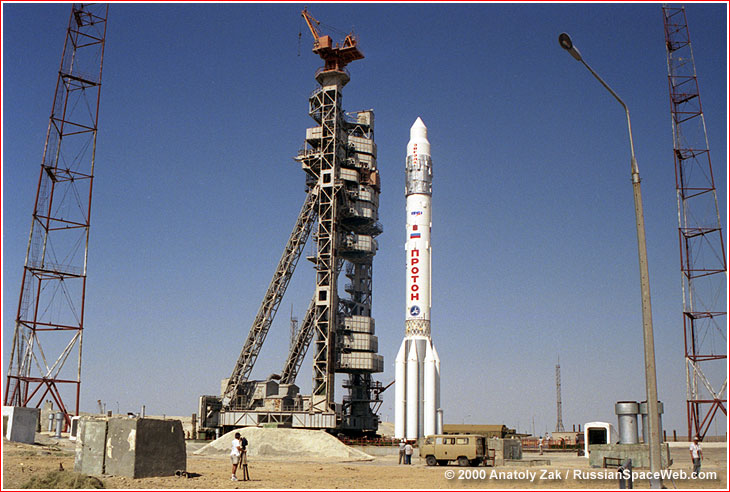
Proton rocket with the Zvezda Service Module shortly after its installation on the launch pad on July 8, 2000.
Resolving the engine problem
After two Proton failures in 1999, investigators determined that a production flaw in the second-stage engines produced in 1992 and 1993 was the culprit. As a result, GKNPTs Khrunichev, the Proton's manufacturer, initiated a fast-paced effort to certify newly modified engines before the launch of the Zvezda Service Module.
"We practically built the engines for this rocket from scratch," the company's Director General Anatoly Kiselev told the editor of this web site in early 2000. "The crucial elements of the engines, such as gas generators and turbopumps will all be upgraded to improve their reliability (as well as) better materials and an improved design will be used," Kiselev said. In addition, a series of four or five test firings at KB Khimmash to validate the upgrades were being scheduled ahead of Zvezda's liftoff. "We don't have those engines yet, however, we hope Voronezh (KB Khimmash) won't let us down (in meeting the July deadline)," Kiselev said.
Kiselev also said that the rest of the Proton fleet was on track to return to flight on February 12, 2000, with the launch of the Garuda communications satellite.
In preparation for the launch, the propulsion experts used special probes to carefully inspect the engines in three fully assembled Proton rockets that were already delivered to Baikonur by the start of 2000, as well as in the rockets undergoing final assembly at Khrunichev's production plant in Moscow. "They all turned out to be clean," Kiselev said.
On January 31, 2000, KB Khimmash also conducted a test firing of the second-stage engine intended to simulate the conditions of the Proton rocket crash on October 26, 1999, which resulted in the loss of the Express-A1 communications satellite.
According to several sources in Moscow, the amount of contamination that was intentionally introduced into the engine during the test firing actually exceeded the level which could conceivably be present in the engine as a result of the production rule violations and/or fueling problems. The contaminants were reportedly added into both propellant tanks and turbo pumps. Still, the preliminary data showed that the engine performed flawlessly during the test. Some experts questioned the importance of the test, even before it was conducted, because the results of the firing were not likely to affect the decision to resume Proton operations.
Proton launch manifest
Khrunichev's director expressed confidence that the company would be able to catch up with its piling up list of missions. "We can fire three or even four Protons a month," Kiselev said.
Kiselev agreed to outline Khrunichev's latest plans for Proton launches as of early February 2000:
- February 12: The Indonesian Garuda-1 communications satellite;
- February 29: The Russian Ekspress-A communications satellite;
- March: The first Sirius broadcasting satellite, previously known as CD Radio;
- April: The Russian Gorizont communications satellite;
- June: The Russian Ekran communications satellite;
- June: A Russian data-relay and communications satellite;
- June: The Zvezda service module for the ISS.
Several other Proton payloads were identified as slated for launch in 2000:
- The second Sirius communications satellite;
- The Sesat communications satellite;
- A cluster of three GLONASS navigation satellites.
At the time, three launch pads for Proton rockets were operational in Baikonur. Pad 23 and Pad 24 at Site 81 were still operated by the military and Pad 39 at Site 200 had recently been transferred to the Rosaviakosmos. The fourth existing pad -- Pad 40 at Site 200 was officially classified as under renovation.
The race begins
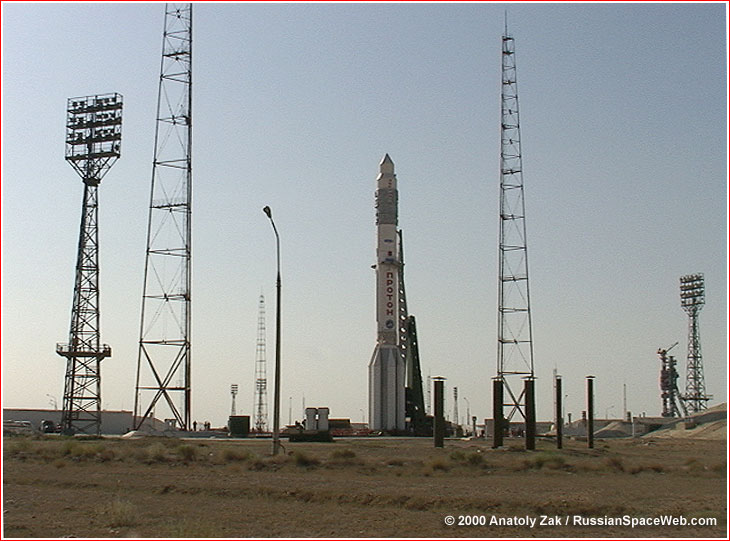
Proton rocket with the Zvezda Service Module shortly after its installation on the launch pad on July 8, 2000. The access gantry for the neighboring Pad 24 can be seen on the right.
The successful launch of the Garuda-1 communications satellite on February 12, opened a floodgate of Proton missions. Two more communications satellites, Ekspress and Sesat, flew within a month from each other in March and April. After that, things only heated up, with four missions under tight deadlines in the next few months. A Russian government decree required the launch of another Ekspress satellite in the 2nd Quarter of 2000 and a commercial contract between GKNPTs Khrunichev and US-based Sirius radio set up the June 30 deadline for the launch of the company's first broadcasting satellite. Above all of that was looming the internationally agreed launch of the Zvezda Service Module, SM, in July.
In the second half of May, Khrunichev officials said they were up to the challenge of launching the Zvezda Service Module on July 12 and preceding it with two launches of Protons equipped with modified engines. The first rocket with upgraded engines was shipped from Khrunichev's production plant in Moscow to Baikonur at the end of April 2000 and it was scheduled to take off on June 5 carrying the Gorizont-45 communications satellite.
The second modified Proton (that had to take off prior to the Zvezda launch) was then still being assembled in Moscow and it was scheduled to leave for Baikonur on May 26, Yuri Gorodnichev, the chief-engineer of the Khrunichev production plant told the editor of this web site.
Around that time, the second modified rocket was re-scheduled to fly from June 20 to June 27, 2000, carrying the Geyzer relay satellite for the Russian Ministry of Defense. The success of that launch would be considered as the final green light for Zvezda.
As of April, the Proton rocket No. 39801, intended for Zvezda was still going through final electrical tests at Khrunichev and it was scheduled to be shipped to Baikonur on May 28.
By June, the launch campaigns for the Russian civilian Ekspress satellites and military Geyzer satellites came into a schedule conflict over whose payload would fly first. According to some reports, the Geyzer launch was ultimately pushed behind its window on June 27, letting Rosaviakosmos to fulfill its obligation to the Kremlin with the delivery of the third Ekspress-A satellite. There were some unconfirmed rumors that Rosaviakosmos had proposed to use the rocket with modified engines for the Ekspress mission, due to delays with the delivery of the Geyzer satellite, but the Russian Ministry of Defense rejected the idea.
As a result, an unprecedented four launches of the Proton rocket were now planned in June 2000. Counting the Geyzer launch, a total of three Proton missions were crowded in the last 10 days of June.
Two Protons with standard engines were scheduled to take off at the end of the month: on June 22, a Proton with the Ekspress-A3 satellite for the Russian Satellite Communications Company and on June 30, another Proton with the Sirius-1 satellite.
However, Kyle Herring, a NASA Johnson Space Center spokesperson, said that according to information provided by Rosaviakosmos, the second Proton launch with modified engines was still set for June 30 and NASA documentation still listed Geyzer as a payload for this launch.
In any case, a critical review meeting to give the go-ahead for the fueling and other irreversible operations with the Zvezda Service Module was set for a period between June 26 and 28, which ended up being before the second Proton (with modified engines) was to take off. Previously, Rosaviakosmos had hoped to conduct the second and final validation launch with the new engines before giving the go-ahead to fueling the Zvezda.
Ekspress-A3 flew successfully on June 24, while around four days earlier, the decision was made to fly Sirius-1 next, pushing the make-or-break launch of the Proton with modified engines to July 5, or barely a week before the planned launch of Zvezda. That super-tight schedule was complicated by the fact that only two workplaces were available at the time inside the vehicle assembly building at Site 92-1 to bolt payloads to their respective Protons. Fortunately, the processing teams from the Russian Strategic Missile Forces and GKNPTs Khrunichev, whose managers had anticipated the coming schedule conflict, took the initiative and pre-positioned a ready-to-fly rocket for the Sirius-1 launch at the just completed assembly site inside Building 92A-50. When it became clear around June 20, that Sirius-1 would fly first, the rocket for the Geyzer mission was also moved to the 92A-50 facility to free the final assembly site inside Building 92-1.
In the end, Sirius-1 lifted off successfully from Pad 24 at Site 81 on July 1 local and Moscow time, but it was still June 30 in New York, the home of the satellite's operator.
On the knife's edge
The day after the Sirius spacecraft reached orbit, another Proton with the Geyzer satellite was rolled out to Pad 39 at Site 200, just eight days after the previous launch with Ekspress-A3 from the same pad.
The modified rocket, so critical for the follow-on Zvezda mission, lifted off at dawn on July 5 and successfully delivered the Geyzer spacecraft into its orbit. However, the telemetry quickly revealed that the pressurization of the propellant tanks on the second stage had collapsed at L+194 seconds into the flight, or around one third of the way into the operation of the booster. By the end of the planned second-stage burn, its RD-0210/0211 propulsion system was on the brink of failure, because pressurized gas was not filling the void in the tanks left by the consumed propellant and, as a result, the required pressure was falling at the entrance into the engine's pumps, threatening a fatal cavitation effect in the propellant-starved turbine. Fortunately, the tremendous acceleration of the rocket, low concentrations of gas in the propellant and the built-in resistance of the engines to cavitation allowed the propulsion system to complete its job.
The flight history of the Proton rocket did not have similar failures, while the telemetry from the Geyzer launch showed normal operation of the gas generator providing pressurization of the tank and the proper work of the reverse valve on the fuel tank. Therefore, it appeared that the breach took place somewhere in between. The investigators suspected that it could have been in the bellows connecting sections of the pressurization line.
In any case, Russian space officials ruled out a repeat of the problem in the upcoming launch of the Zvezda Service Module just few days away... (911)
A summary of Proton missions in 2000:
| - | Date | Time | Payload(s) | Launch vehicle | Launch complex | Pad No. | Status |
|---|---|---|---|---|---|---|---|
| 1 | February 12 | 12:10:54 Moscow Time | Garuda-1 | Proton-K/Block DM3 No. 15L | 81 | 23 | Success |
| 2 | March 12 | 07:07:00 Moscow Time | Ekspress-A No. 2 | Proton-K/Block DM-2M No. 10L | 200 | 39 | Success |
| 3 | April 18 | 00:05:59 Moscow Time | Sesat | Proton-K/Block DM-2M No. 9L | 200 | 39 | Success |
| 4 | June 6 | 06:58:59 Moscow Time | Gorizont No. 45 (11F662) | Proton-K*/Briz-M No. 2L | 81 | 24 | Success |
| 5 | June 24 | 02:28:00 Moscow Time | Ekspress-A No. 3 | Proton-K/Block DM-2 No. 89L | 200 | 39 | Success |
| 6 | July 1 | 01:08:46 Moscow Time | Sirius-1 (CD Radio) | Proton-K/Block DM3 No. 29L | 81 | 24 | Success |
| 7 | July 5 | 02:43:59 Moscow Time | Geyzer (Potok, Kosmos-2371) | Proton-K*/Block DM-2 No. 90L | 200 | 39 | Success** |
| 8 | July 12 | 07:56:36 Moscow Time | Zvezda Service Module | Proton-K | 81 | 23 | Success |
| 9 | August 28 | 23:07:59 Moscow Time | Globus-1 No. 16L (Raduga-1) | Proton-K/Block-DM-2 No. 87L | 81 | 24 | Success |
| 10 | September 5 | 12:43:58 Moscow Time | Sirius-2 (CD Radio) | Proton-K/DM-3 No. 22L | 81 | 23 | Success |
| 11 | October 2 | 01:00:00Moscow Time | GE-1A | Proton-K/Block DM-3 No. 13L | 81 | 23 | Success |
| 12 | October 13 | 17:12:44 Moscow Time | Kosmos-2374, Kosmos-2375, Kosmos-2376 (GLONASS) | Proton-K/DM-2 | 81 | 24 | Success |
| 13 | October 22 | 01:00:00 | GE-6 | Proton-K/DM3 No. 19L | 81 | 23 | Success |
| 14 | November 30 | 22:59:47 | Sirius-3 | Proton-K/DM-3 | 81 | 23 | Success |
*The vehicle was equipped with Phase 2 engines on the second and third stages
**A second stage failure does not affect the outcome of the mission
Next chapter: Proton operations in 2001
Article and photos by Anatoly Zak; Last update:July 12, 2020
Page editor: Alain Chabot; Last edit: July 12, 2020
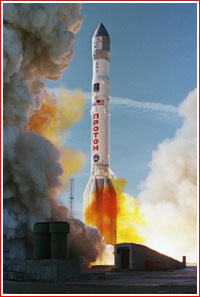
Proton rocket returns to flight on February 12, 2000, with the Garuda-1 communications satellite after a failure in October 1999.
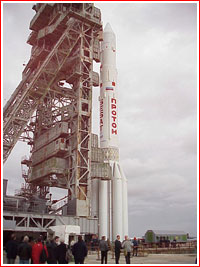
A Proton rocket with the SeSat communications satellite on the launch pad in Baikonur in April 2000.
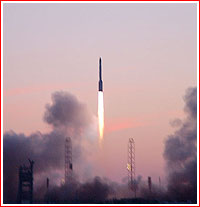
Proton lifts off with a Geyzer satellite on July 5, 2000. Credit: Fedor Yurchikhin
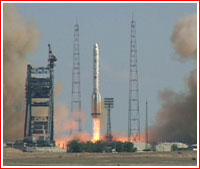
A Proton rocket lifts off with the Zvezda Service Module on July 12, 2000. Copyright © 2000 Anatoly Zak
